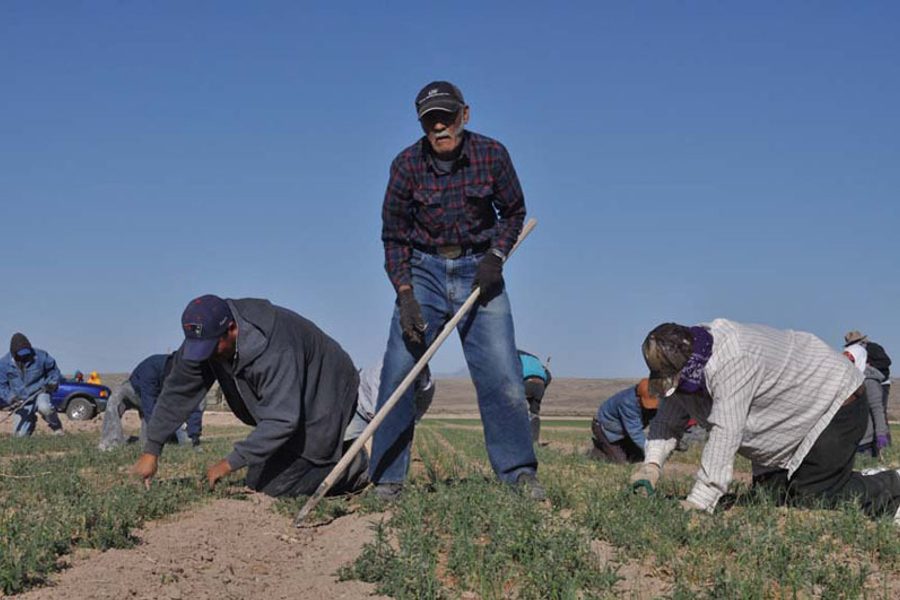Don’t Celebrate Yet: Warning Letter Didn’t Halt Wage Theft in New Mexico Fields
Joseph Sorrentino

Following an investigation I conducted for In These Times last year that exposed wage theft in New Mexico’s chile fields, it looked as though New Mexico Department of Workforce Solutions (DWS) was taking action to ensure that chileros (chile pickers) and other farmworkers in the state were finally going to get the pay they’re legally entitled to. But new findings suggest that hourly workers are still being shorted and the DWS is doing little, if anything, about it.
In December 2013, I reported that, when paid hourly, farmworkers in New Mexico were routinely paid less than the state minimum wage of $7.50 an hour. For years, contratistas (labor contractors) and growers had erroneously believed they were only required to pay the slightly lower federal minimum of $7.25. I,reported this to DWS and, after attorneys at the New Mexico Center on Law and Poverty (NMCLP) applied some additional pressure, DWS sent out a letter earlier this year informing all registered contratistas that they were required to pay the higher state wage.
However, when I returned to the fields to do follow-up reporting this April, it appeared that the letter had had little effect on the hourly wages paid for weeding.
Chile and onion fields are weeded manually. Workers use hoes to dig up the weeds that in between the rows of crops, but for weeds that grow between the chile plants or onions, workers get on their knees and pull them out by hand. It may not be the most strenuous work that farmworkers do, but it produces sore backs and knees and by mid-morning, the heat from the southern New Mexico sun begins to take its toll. For this kind of labor, workers are paid by the hour (when harvesting crops, they’re typically paid a piece rate, getting paid a certain amount for what they pick).
On my trip, I interviewed more than a dozen farmworkers who were employed weeding onion fields in southern New Mexico. I also checked their wage receipts. Nearly every worker I spoke with and every receipt I saw showed that they were still being paid only $7.25 an hour. The only exception was a farm found to be paying $7.50 an hour — but, fearing retaliation by contratistas or other farmers, the manager asked that I not identify him or the farm.
Tess Wilkes is a determined young attorney at NMCLP who has been fighting for farmworkers’ rights for several years. When I informed her about this continuing example of wage theft, she, along with other staff from NMCLP and the Texas RioGrande Legal Aid, decided to coordinate a field visit with DWS. To do this, Wilkes and her team (but not DWS) arrived on the streets of El Paso at 2a.m., along with dozens of workers who were waiting to be hired. After the contrastista vans picked up the workers, the NMCLP team tailed them to a field just off the road. The team lucked out: They’d happened to follow a contratista who I knew consistently paid workers $7.25 an hour. As required by law, he had a wage poster on display at the field — but it was the federal wage poster, specifying the $7.25-an-hour minimum. There was nothing about the state wage of $7.50. Soon after they arrived, Wilkes called a DWS labor law administrator, who is responsible for investigating what workers are paid. Once the investigator arrived, Wilkes and the others left.
Wilkes says she been unable to get any information about what the investigator found or what actions, if any, are being taken. She says she’s called and emailed the investigator several times but hasn’t gotten a response.
Meanwhile, I emailed Jason Dean, division director of the Labor Relations Division at DWS and the author of the letter to the contratistas. I sent evidence that the $7.50 wage was not being enforced: copies of workers’ receipts showing they were getting paid the lower wage. I asked Dean what DWS was doing to investigate wage theft. He didn’t respond. I was finally able to reach Joy Forehand, DWS’s deputy cabinet secretary, by phone and she relayed questions to Dean. According to Forehand, Dean said that DWS will continue to carry out random audits, although the one coordinated by the NMCLP is the only one they’ve done so far. No information is available about what the investigator found on that site visit. Forehand said, “There was further investigation, and any claims [have] been investigated and closed,” but did not respond to requests for more detail.
Forehand was told that contratistas are displaying the federal minimum wage poster, and that it was the only one available on the DWS website. “We’re working [on a state poster] with Dean,” she said. “We have a draft of a poster. We’re looking at the end of the summer” for it to be ready. By that time, the fieldwork season will be finished for the year, except for a small red chile harvest.
Chileros are among the lowest paid workers in the United States, earning around $9,000 a year. Twenty-five cents more an hour would net them just a few extra dollars a week, but when you’re earning so little, any increase is going to help. “With $8 or $10 extra, I could buy food for my children, pay a bill,” says Jorge Alferez, a 55-year-old chilero who splits his time between his home in Ciudad Juárez and El Paso, Texas.
Wilkes took a more legalistic approach. “It doesn’t matter what the amount is,” she says. “It’s a violation of the law.”

I hope you found this article important. Before you leave, I want to ask you to consider supporting our work with a donation. In These Times needs readers like you to help sustain our mission. We don’t depend on—or want—corporate advertising or deep-pocketed billionaires to fund our journalism. We’re supported by you, the reader, so we can focus on covering the issues that matter most to the progressive movement without fear or compromise.
Our work isn’t hidden behind a paywall because of people like you who support our journalism. We want to keep it that way. If you value the work we do and the movements we cover, please consider donating to In These Times.






